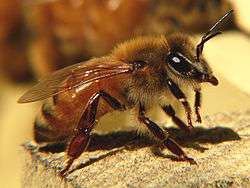Hymenoptera training

Sniffer bees or sniffer wasps are insects in the order Hymenoptera that can be trained to perform a variety of tasks to detect substances such as explosive materials or illegal drugs, as well as some human and plant diseases. The sensitivity of the olfactory senses of bees and wasps in particular have been shown to rival the abilities of sniffer dogs, though they can only be trained to detect a single scent each.
Sniffer wasps have also been a popular topic in the critical thinking AQA AS exam. It first appeared in the 2001 AS June paper and has been a regular subject of knowledge in recent years.
Intelligence
Ethologist Karl von Frisch dedicated much of his career to the study of the sensory perceptions of the honey bee and was one of the first people to translate the meaning of the waggle dance.[1] His studies show that bees can count to five and have the capacity to be trained to visit specific feeding stations at certain times of day.[2]
Odour detection
Bees and wasps are trained using classical conditioning, being exposed to a particular odour and then rewarded with a sugar solution.[3] Within five minutes they learn to associate the smell with an impending supply of food and this triggers the proboscis extension reflex (sticking out their tongues).[4]
Trained hymenopterans have been shown to successfully detect explosive materials including TNT, Semtex, and C-4 as well as gunpowder and propellants.[3][5] Wasps can be trained to detect the early signs of fungal disease on crops and may have medicinal value, identifying people with cancer just by being exposed to their breath.[6] Bees have been shown to detect and respond to more than 60 different odours including methamphetamine, uranium, and tuberculosis. They have been used to detect lung and skin cancers, diabetes, and to confirm pregnancy.[2] It is not known if they can detect potential seizures in humans.
Researchers at the University of Georgia have built a device named the "Wasp Hound" which contains the parasitic wasp species Microplitis croceipes. The insects normally walk around the PVC pipe in which they are housed but begin to migrate towards the source of an odour when it is the one that they were trained to recognise. These movements are tracked by a computer, with small cameras inside the device sending images for processing. Within 30 seconds of the wasps beginning to congregate near an odour source an alarm is sounded.[7]
References
- ↑ J.R. Riley, U. Greggers, A.D. Smith, D.R. Reynolds, and R. Menzel (12 May 2005) "Letters to Nature: The flight paths of honeybees recruited by the waggle dance," Nature, vol. 435, pages 205-207.
- 1 2 Halter, Reese. Bees: man's best friend, provider and protector. 2 November 2010. Accessed 6 October 2011.
- 1 2 Hodgson, Martin. Sniffer bees: New flying squad in war against terror Archived July 9, 2012, at the Wayback Machine.. The Independent. 7 May 2006. Accessed 6 October 2011.
- ↑ Trained Wasps May Be Used To Detect Bombs, Bugs, Bodies And More. Science Daily. 21 October 2005. Accessed 6 October 2011.
- ↑ Detecting Explosives With Honeybees: Experts Develop Method To Train Air Force Of Bomb-Sniffing Bees. Science Daily. 29 November 2006. Accessed 6 October 2011.
- ↑ Hall, Mimi. Scientists recruit wasps for war on terror. USA Today. 26 December 2005. Accessed 6 October 2011.
- ↑ Appel, Adrianne. Drug-Sniffing Wasps May Sting Crooks. National Geographic. 27 October 2005. Accessed 6 October 2011.
External links
- The early bee catches the flower - circadian rhythmicity influences learning performance in honey bees, Apis mellifera. 31 July 2010.
- Can Honey Bees Assist in Area Reduction and Landmine Detection?. December 2003.
- First evidence of fine colour discrimination ability in ants (Hymenoptera, Formicidae)
- Bees help in the battle against tuberculosis, 3 News. 27 October 2011.